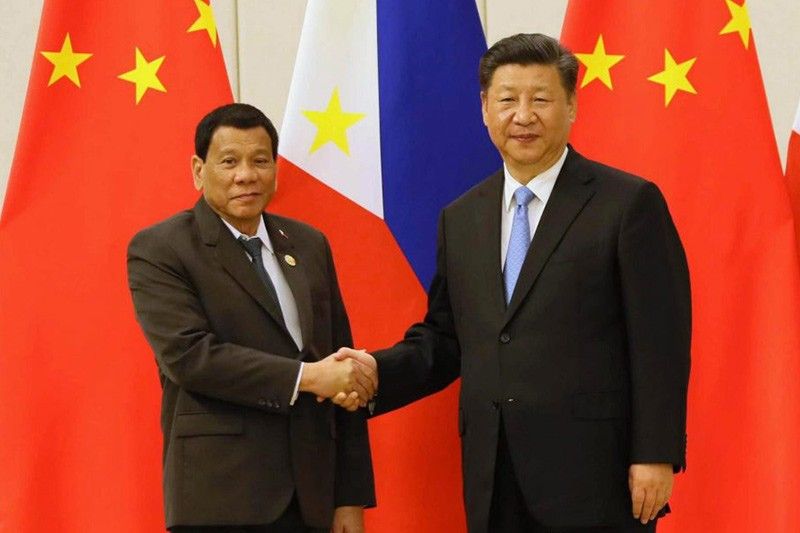Commentary: Appeasing the 'dragon' is a folly

On Feb. 8, 2021, Department of Foreign Affairs Secretary Teodoro Locsin revealed that the Philippines and the United States will meet in late February to iron out their differences over the 1999 Philippine-US Visiting Forces Agreement amid unconfirmed reports that the two allies will negotiate a new agreement to replace the 21-year-old agreement.
Talks about a new agreement that will replace the VFA began circulating around the airwaves after Philippine Ambassador to the US Jose Manuel Romualdez disclosed, in a virtual forum organized by the Foreign Correspondent Association of the Philippines, that the US was seeking a meeting with the Philippine government over the treaty. He said that the VFA could be tabled at the Bilateral Strategic Dialogue between the two countries. Accordingly, the discussion will revolve around the 1951 Mutual Defense Treaty (MDT) and of course, the VFA.
Earlier in November 2020, Locsin announced the second six-month suspension of the VFA’s termination. This was seen as the Duterte administration’s effort to offer an extension that would provide Manila and Washington more time to discuss options for the VFA, given the change in administration in the United States.
In his diplomatic note to then US National Security Adviser Robert O’Brien, Locsin said that the six-month suspension of the agreement’s abrogation will enable the Philippines and the US “to find a more enhanced, mutually agreeable, and more effective and lasting arrangement on how to move forward in our mutual defense.”
Washington responded by sending ranking US defense and state departments officials, including then Acting Secretary of Defense Christopher Miller, to reaffirm the relevance of the alliance in advance of negotiation for the new VFA. A successful negotiation of a new status of forces agreement will signal the Philippines’ willingness to work with the Biden administration in addressing security concerns such terrorism and China’s expansion in the South China Sea.
One step forward, two step backward
Exactly one year ago, President Rodrigo Duterte ordered Locsin to deliver a diplomatic note informing the US that he is unilaterally terminating the VFA. The agreement was supposed to end in August 2020.
However, Duterte ordered the suspension of its termination in June and again, in November 2020. Now his administration is ready to negotiate a new agreement that will enable the US to honor its commitment to the decades-old MDT that would help maintain the “balance of power in the Asia-Pacific—including the South China Sea.”
The Duterte administration’s decision to renegotiate a new VFA can be attributed to one reason—China’s aggressive actions in the South China Sea. On February 17, a People’s Liberation Army’s Navy’s (PLAN) corvette directed its Gun Control Director (GCD) to the Philippine Navy’s (PN) anti-submarine corvette the BRP Conrado Yap near Rizal Reef in the South China Sea. This is the first time that a PLAN warship directly threatened a Philippine public vessel in the South China Sea.
In March, a Chinese military transport plane landed on Fiery Cross or Kagitingan Reef on a routine supply mission aimed for a low-level consolidation of its control of the South China Sea.
In early April, China started the operations of two maritime research stations in two artificial islands that are claimed by the Philippines: Fiery Cross or Kagitingan and Subi or Zamora Reefs. On April 18, the State Council of the city of Sansha announced the establishment of two new districts to administer the disputed waters in the South China Sea.
In late December 2020, satellite images revealed that China deployed its largest warplane, the Y-20 transport, to Fiery Cross Reef, the first time this type of aircraft was deployed in the Spratlys. The deployment was followed by a series of Chinese military exercises in the waters surrounding Hainan Islands.
The folly of appeasing the dragon
On Jan. 23, 2021, the Standing Committee of the China’s National People’s Congress passed the Chinese Coast Guard (CCG) Law, which allows coast guard vessels to use all necessary means to stop or prevent threat from foreign vessels.
A week later, Locsin ordered the filing of a diplomatic protest against China for the passage CCG law, citing that it is a verbal threat of war to any country that defies the law; which, if unchallenged, is submission to it.
Defense Secretary Delfin Lorenza, too, called on claimants in the region to “exercise caution and carefulness” and with regard to countries outside the region, like the United Kingdom, Australia, and India, the secretary said that the Philippines would continue to engage them “to find ways to move forward.”
The heightened tension in the South China Sea, triggered by Chinese aggressive moves, persuade the Duterte administration to suspend the VFA’s suspension for the second time. The CCG’s passage is the latest of a series of Chinese assertiveness that pushed the current administration to place the alliance on a firmer footing with the Biden Administration by negotiating a new VFA.
More significantly, it also exposed the folly of appeasing a dragon bent on expanding into the South China Sea.
Renato de Castro is the trustee and convenor of the National Security and East Asian Affairs Program of think tank Stratbase ADR Institute.
- Latest
























